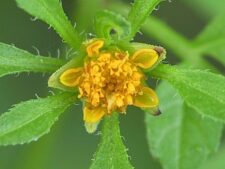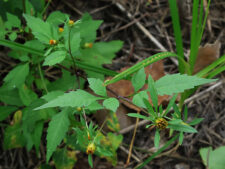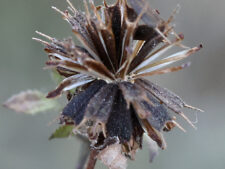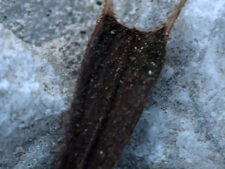
DEVIL’S BEGGAR TICKS
Bidens frondosa
SUNFLOWER FAMILY (Asteraceae)
 Identification
Identification
- Flowering Time - August, September, October
- Uncommon in wet places on floodplain at FF
- Leaves divided into 3-5 leaflets
- Less than 10 leafy bracts at base of flower
- Very similar to Bidens vulgata - see Comments
This annual grows up to 3 feet tall. The leaves are divided into 3 or 5 lance-shaped, toothed leaflets. They are opposite on smooth, usually purple stems (C,D). The yellow-orange flower heads are framed by 5-9 slender leaf-like bracts (A). Petal-like ray florets are very small (B) or absent. Round seed heads contain many flat, brown seeds with 2 barbed awns designed to attach to any fur or clothing bearing creature passing their way.
Grows along ditches, streams, and rivers, flowering from August through October. Uncommon along stream or in wet ditches on the Fontenelle Forest floodplain. Not recently documented at Neale Woods, but likely there in similar habitats.
Devil’s Beggar Ticks (B. frondosa) and Tall Beggar Ticks (B. vulgata) have once divided leaves with 3-5 leaflets separating them from the the other 3 Bidens species that have been identified recently at Fontenelle Forest and Neale Woods. Their seeds also quite consistently have only 2 barbed awns; the others have either very different elongated needle-like seeds or similar seeds with 3 or 4 awns. Devil’s and Tall Beggar Ticks are quite similar and separating these may not always be possible. As the common name suggests, Tall Beggar Ticks is generally a taller, more robust plant with larger central flower heads, but the most reliable way to separate them is to look at the leafy bracts lying just below the flower head. Devil’s Beggar Ticks has fewer (5-9), more delicate bracts while Tall Beggar Ticks has 10 or more.
The genus name, Bidens, means two teeth. It was prompted by the two barbed awns found on the seeds of some Bidens species including Devil’s and Tall Beggar Ticks. Other species in this genus usually have more (up to 4 awns).
The content of NatureSearch is provided by dedicated volunteer Naturalists of Fontenelle Forest who strive to provide the most accurate information available. Contributors of the images retain their copyrights. The point of contact for this page is: Roland Barth.





